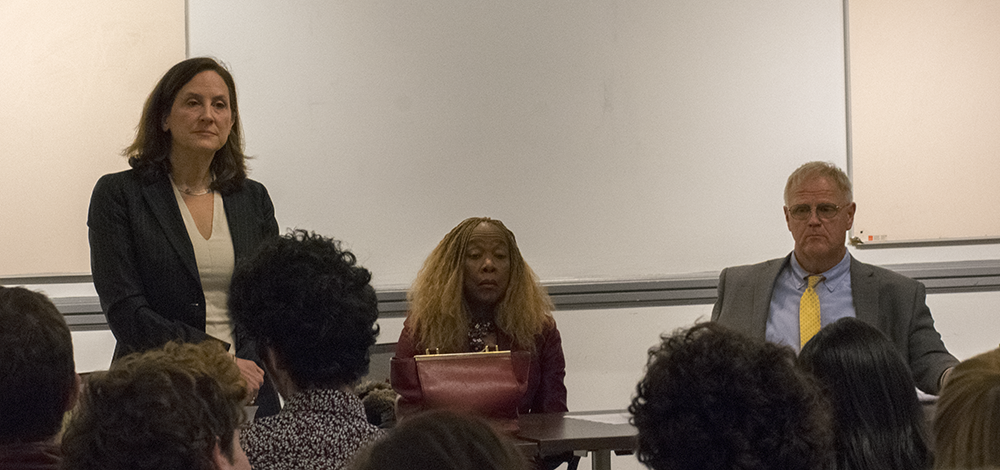
Georgetown University’s 2019 Sexual Assault and Misconduct Climate Survey is set to open to the student body Friday and run through March 1.
The national survey is administered by the Association of American Universities, which designed the survey to assess the frequency of campus sexual assault and misconduct in a manner that protects student confidentiality and allows for data sharing across universities. The AAU will publicly release results from participating universities.
Georgetown launched its first Campus Climate Survey in January 2016, just after 27 universities conducted the survey through the AAU in 2015. The upcoming survey will take place at 33 universities across the country and is expected to be the largest of its kind, according to the AAU.
University President John J. DeGioia sent an email announcing the release of the survey to students Jan. 31.
“I urge all of our students to participate and to encourage your peers to also participate in this important activity for our University community,” DeGioia wrote.
Students will receive an email from the research firm Westat, which is administering the survey.
Georgetown is urging student participation in the voluntary survey to continue to inform its efforts to combat sexual assault on campus, according to Vice President for Student Affairs Todd Olson and Vice President for Institutional Diversity and Equity Rosemary Kilkenny.
“We encourage students to make their voices heard in this survey so we can hear about student experiences, understand what students face, and learn how new resources and programming are serving students,” Olson and Kilkenny wrote in a September viewpoint in The Hoya.
In Georgetown’s inaugural climate survey, 31 percent of female undergraduates reported experiencing nonconsensual sexual contact on campus. The 2016 survey results also showed that 10.8 percent of males experienced nonconsensual sexual contact in their time at Georgetown.
The survey participation rate at Georgetown in 2016 was 51 percent of students, compared to an average of 19 percent participation among all schools that administered the survey.
Continuing to collect data through this survey will allow for the university to monitor its progress over time, according to Kilkenny.
“Data from this year’s results will help the university assess the impact of recommendations and programming implemented since the last survey,” Kilkenny wrote in a statement to The Hoya. “The survey includes most of the same questions as the first to provide us with reliable data comparisons.”
DeGioia created the Sexual Assault and Misconduct Task Force, composed of over 70 faculty, staff and students, in response to the 2016 survey findings to recommend methods to address sexual misconduct in the campus community.
In fall 2017, the Sexual Assault and Misconduct Advisory Committee was established to implement the 11 recommendations of the task force.
SAMAC released a progress update in fall 2018 detailing its work, which included adding a full-time staff member to the office of Health and Education Services, providing trauma-informed training for Georgetown University Police Department officers on the Sexual Assault Response Team, and recommending language on sexual misconduct for course syllabi.
The new climate survey may serve to push the university to address many of these recommendations that it has thus far failed to address, according to Students Taking Action Against Interpersonal Violence member Kory Stuer (COL ’19).
One of the recommendations of the task force was to implement a coordinated community response team, a group that would focus on misconduct prevention and addressing survivors’ needs. Though the response team has not yet been created, SAMAC is continuing to develop the group and aims to have a structure in place by the end of the spring semester.
The recommendations also included measures to increase academic research around sexual violence, such as the establishment of centers dedicated to research sexual assault and the creation of a sexual violence studies major and minor.
The 2019 climate survey comes amid rising reports of sexual assault, Georgetown’s ongoing search for a Title IX coordinator and proposed changes in Title IX regulations.
The number of reports of sexual assault made through Georgetown’s Title IX Office nearly doubled between the 2015-2016 and 2016-2017 academic years, from 81 to 161. Likewise, in Washington, D.C., the number of reports of sexual assault made to the Metropolitan Police Department increased between January and June 2018.
Following the U.S. Department of Education’s proposed Title IX regulation changes, the university submitted a comment on the proposed changes Jan. 30. The comment took into account student input from 11 listening sessions, anonymous feedback and a town hall run by STAIV.
Contributions from community members were critical in the effort to combat sexual misconduct on campus, according to Kilkenny.
“We have seen widespread engagement and dedication to this issue from hundreds of Georgetown community members, and we hope students remain engaged and help promote the survey,” Kilkenny wrote. “Every voice is important, and it’s important we hear from as many members of our community as possible as the survey will provide valuable insights that will shape our continued work on this issue.”
This article was updated Jan. 31 to clarify when Georgetown conducted its first Campus Climate Survey.




















